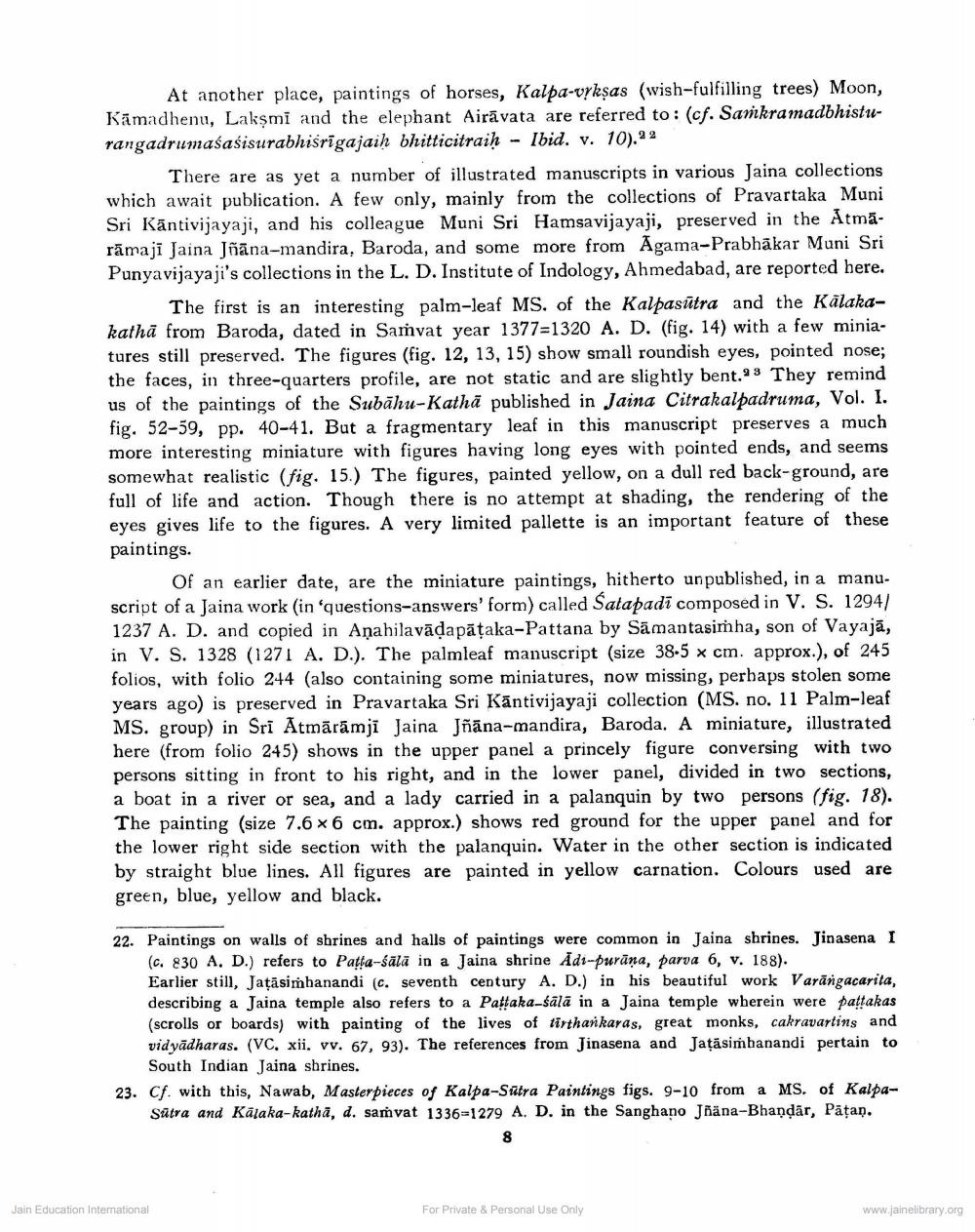________________
At another place, paintings of horses, Kalpa-vykşas (wish-fulfilling trees) Moon, Kamadhenu, Lakşmi and the elephant Airāvata are referred to: (cf. Samkramadbhisturangadrumaśaśisurabhisrīgajaih bhitticitraih - Ibid. v. 10).22
There are as yet a number of illustrated manuscripts in various Jaina collections which await publication. A few only, mainly from the collections of Pravartaka Muni Sri Kāntivijayaji, and his colleague Muni Sri Hamsavijayaji, preserved in the Atmārāmaji Jaina Jõāna-mandira, Baroda, and some more from Agama-Prabhākar Muni Sri Punyavijayaji's collections in the L. D. Institute of Indology, Ahmedabad, are reported here.
The first is an interesting palm-leaf MS, of the Kalpasūtra and the Kālakakathā from Baroda, dated in Samvat year 1377=1320 A. D. (fig. 14) with a few miniatures still preserved. The figures (fig. 12, 13, 15) show small roundish eyes, pointed nose; the faces, in three-quarters profile, are not static and are slightly bent.29 They remind us of the paintings of the Subāhu-Kathā published in Jaina Citrakalpadruma, Vol. I. fig. 52-59, pp. 40-41. But a fragmentary leaf in this manuscript preserves a much more interesting miniature with figures having long eyes with pointed ends, and seems somewhat realistic (fig. 15.) The figures, painted yellow, on a dull red back-ground, are full of life and action. Though there is no attempt at shading, the rendering of the eyes gives life to the figures. A very limited pallette is an important feature of these paintings.
Of an earlier date, are the miniature paintings, hitherto unpublished, in a manuscript of a Jaina work (in questions-answers' form) called Satapadi composed in V. S. 1294/ 1237 A. D. and copied in Aşahilavādapāțaka-Pattana by Sāmantasimha, son of Vayajā, in V. S. 1328 (1271 A. D.). The palmleaf manuscript (size 38.5 x cm. approx.), of 245 folios, with folio 244 (also containing some miniatures, now missing, perhaps stolen some years ago) is preserved in Pravartaka Sri Kāntivijayaji collection (MS. no. 11 Palm-leaf MS. group) in Sri Atmārāmji Jaina Jñāna-mandira, Baroda. A miniature, illustrated here (from folio 245) shows in the upper panel a princely figure conversing with two persons sitting in front to his right, and in the lower panel, divided in two sections, a boat in a river or sea, and a lady carried in a palanquin by two persons (fig. 18). The painting (size 7.6 x 6 cm. approx.) shows red ground for the upper panel and for the lower right side section with the palanquin. Water in the other section is indicated by straight blue lines. All figures are painted in yellow carnation. Colours used are green, blue, yellow and black.
22. Paintings on walls of shrines and halls of paintings were common in Jaina shrines. Jinasena I
(c. 830 A, D.) refers to Patta-śālā in a Jaina shrine Adi-purāna, parva 6, v. 188). Earlier still, Jaţāsimhanandi (c. seventh century A. D.) in his beautiful work Varāngacarita, describing a Jaina temple also refers to a Pattaka-śālā in a Jaina temple wherein were pattakas (scrolls or boards) with painting of the lives of tirtharikaras, great monks, cakravartins and vidyādharas. (VC. xii. vv. 67, 93). The references from Jinasena and Jaţăsimhanandi pertain to
South Indian Jaina shrines. 23. Cf. with this, Nawab, Masterpieces of Kalpa-Sutra Paintings figs. 9-10 from a MS. of Kalpa
Sätra and Kalaka-kathā, d. samvat 1336=1279 A. D. in the Sanghano Jñäna-Bhandar, Påțan.
Jain Education International
For Private & Personal Use Only
www.jainelibrary.org




